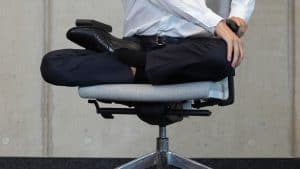Sitting for long hours with little to no exercise is something really normalized, especially if you are an office worker. But this sedentary lifestyle costs us a lot of health points and paves the way for numerous problems like chronic pain and hypertension.
One such complication that sitting for long hours can cause is Sciatica, which can be a symptom of some major health concerns like Piriformis Syndrome, Herniated Disk, and even Tumors inside the spine. Someone suffering from Sciatic nerve pain, experiences mild to intense pain radiating from their lower back to the buttocks region and going till the lower legs.
This is because the sciatic nerve, which is one of the major nerves in our lower body and connects the spine to the lower legs, is compressed or put under undue pressure. The cause could be an inflamed muscle or bulging spinal disk, but in the end, this results in pain for the patient while doing even the most basic activities, especially sitting.
Sitting, you see, increases the pressure on the already compressed sciatic nerve irritating it further. Thus, sitting for long periods with Sciatic nerve pain is a difficult job. But what if your job requires you to sit for long periods at the desk and work? It would be quite a predicament, wouldn’t it?
And that’s what I am here for! To tell you how to sit comfortably with Sciatica when it is unavoidable and what else you can do to elevate the pain. Read on!
Table of Contents
- Is It Better to Sit or Lay Down With Sciatica?
- Does Sitting Make Sciatica Worse?
- Why Does My Sciatic Nerve Hurt When Sitting?
- Correct Way to Sit with Sciatica
- What is the Most Effective Pain Relief for Sciatica?
- Conclusion
Is It Better to Sit or Lay Down With Sciatica?
When it comes to Sciatica, the best option is to move around but if you have to choose between sitting and lying down, avoid sitting with Sciatica. This is because Sciatica is essentially the compression of the sciatic nerve; the pressure is what makes the pain flare-up by irritating the nerve, and sitting just makes it worse.
Sitting, especially in a bad posture, puts more pressure on the sciatic nerve. While lying down, in most cases, relieves the pressure to at least some extent and decreases the pain and discomfort. So when it comes down to the basics, lying down is the better option for Sciatica, but not the best. The best option is to get moving and take a more proactive approach to treat Sciatica.
Does Sitting Make Sciatica Worse?
Sitting for too long without moving much isn’t good even under normal circumstances, and if you are suffering from Sciatica, it’s just inviting more pain. Your sciatic nerve is already under so much pressure and irritated; if you keep sitting, you will just aggravate it more.
Even if you do not suffer from Sciatica, a sedentary lifestyle might eventually lead you to succumb to it, along with dozens of other health complications. So sitting does not only make Sciatica pain worse, it might even be the root cause of it.
Why Does My Sciatic Nerve Hurt When Sitting?
The sciatic nerve runs from our lower spine to the base of our legs and is one of the major nerves that allow us to move our legs and lower body. When you are sitting, particularly with bad posture, it affects your back, spine, hip bone, and muscles, and eventually, your sciatic nerve.
The sciatic nerve is put under undue pressure and may end up getting compressed by the surrounding muscles or even spinal disks. This constant and ever-increasing pressure obviously hurts the nerve and leads to Sciatica – the pain radiating from the base of your spine towards your lower legs.
Mostly, Sciatic pain is experienced only on one side, the side which is put under pressure more frequently. Sitting on it again and again just irritates the nerve more. So if your sciatic nerve hurts when you sit, it’s because of nerve compression, and you know it’s time for a change.
Correct Way to Sit With Sciatica
If you can’t avoid sitting for long hours, you can still be comfortable if you take heed of just a few precautions. Sometimes, the simplest of changes can bring immense relief, and the following points are the best example of this:
1. The Correct Posture
Sitting for hours in the same place, in itself, is bad for your overall health but adding bad posture to it is a straight-up recipe for disaster! And the disaster here is aching back, crying muscles, and a compressed sciatic nerve. So for treating Sciatic pain, while not compromising with your work, the first thing to do is practice sitting with the correct posture –
- Try to put minimum pressure on the side with the irritated nerve. More pressure can lead to more pain, so you can try shifting your weight to the other side of the hip bone.
- Your lower back should be properly supported, and the natural curve should be adhered to. This is the place where the sciatic nerve is connected with the spine, so any pressure of the spinal disks will inevitably put pressure on the sciatic nerve.
- Feet should be placed firmly on the ground, to be able to properly support your body weight.
- The buttocks and hip bone should be firmly placed on the chair to provide some relief to your spine. Sit on the pointy bones of your hip as they are designed to bear your body weight while sitting.
- Sit straight or tilted forward at a slight angle and do not slouch.
- Your knees should be lower than the level of your hips and would be best if they are not constricted by the seat edges.
But constantly reminding yourself to sit in a certain way can be quite taxing, and there is always a chance of forgetting. In such a case, an sciatica chair that is tailor-made for comfort and correct posture can be a good option to give a try to. You can also set timely reminders if it helps you with correcting the posture.
2. Use a Sciatica Seat Cushion
When you are suffering from Sciatica, sometimes, no matter how you shift your weight or adjust your posture, a slight movement can cause the pain to flare up. Using comfortable chairs is an option, but not everyone can just up and change theirs. That’s where Sciatica pain treatment seat cushions come to the rescue.
These specially designed cushions not only help in relieving the pressure from your lower back and hips but also help you keep up the proper posture. So if you are suffering from sciatic pain and having trouble getting your work done, a Sciatica seat cushion might be just what you need to save the day.
3. Use Heating Pads/Patches
Heating pads or patches are always effective when dealing with pain that involves your muscles. Since they help the heat permeate deep into the tissues, alleviating discomfort, they are one of the best go-to tools if you suffer from Sciatica pain and still need to sit or cross your legs for quite a few hours.
Applying constant heat relieves the soreness of the muscles and decreases the nerve pain and back pain caused by the inflamed tissues and the irritated nerve. The best thing about this method is that you can use it anywhere, outside or inside, at home or in the office. Using hot water bottles, ointments, and heat patches all work fine.
4. Avoid Unnecessary Movement
A lot of the time, when you are working and need something just a bit farther away, you end up stretching your upper body to reach it. This action might seem of little consequence, but it adversely affects our lower back and buttocks. Especially if you are suffering from Sciatica or any other lower body pain, stretching like this can increase the pain and discomfort.
So avoid any unnecessary movement while working, keep everything close at the arm’s distance, and do not put undue pressure on your lower back and muscles. When working on a computer, keep the monitor on your eye-level and the keyboard and mouse at the distance where you can easily access them without pushing yourself.
What is the Most Effective Pain Relief for Sciatica?
There are many ways, apart from a change in sitting habits, that can bring you pain relief if you are suffering from Sciatica. The first and foremost, of course, is to consult a doctor and follow all the instructions diligently, but you can also integrate these points into your lifestyle:
1. Taking Short Walks
Taking short walks or breaks every 25-30 minutes of sitting is really helpful in alleviating the pressure of your back and muscles. The walk improves your circulation too and gets your compressed nerve the much needed time to breathe. Also, using the stairway instead of elevators can be helpful in providing your muscles with the appropriate exercise.
2. Stretch Exercises for Sciatica
Maybe your doctor and physiotherapist have already prescribed you some easy stretching exercise to work up your lower body muscles and alleviate the pressure on your sciatic nerve as physical therapy. Make sure to do them regularly and seriously. Do not be lazy because these exercises and stretches can prove to be the decisive factor in your fight against Sciatica and may help reduce the pain significantly.
Conclusion
Sciatica, though painful, is something we can easily manage as long as we take the initiative. Move around, do stretches, go for walks, and cut the time you spend sitting. If you still have to sit for long hours, take care of your posture, use ergonomic chairs to reduce back pain and get the right lumbar support, and also right seat cushions to help you through with it. You can also apply heat to alleviate pain and do follow your doctor’s instructions properly.
Your comfort, at the end of the day, is in your own hands. Stay safe!

